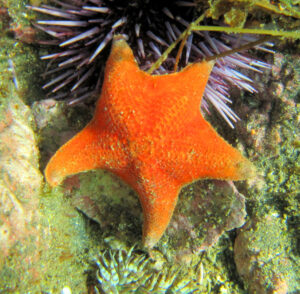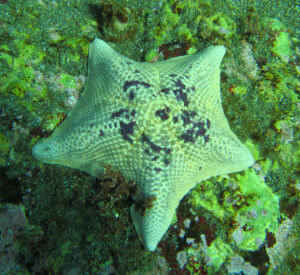Bat Star, Patiria miniate
 Bat Star, Patiria miniate. Underwater photograph taken in coastal waters off Anacapa Island, California, February 2021. Wingspan: 10 cm (3.9 inches). Photograph and identification courtesy of Bob Hillis, Ivins, Utah.
Bat Star, Patiria miniate. Underwater photograph taken in coastal waters off Anacapa Island, California, February 2021. Wingspan: 10 cm (3.9 inches). Photograph and identification courtesy of Bob Hillis, Ivins, Utah.
 Bat Star, Patiria miniata. Underwater photograph taken in coastal waters off Anacapa Island, California, February 2021. Wingspan: 11 cm (4.3 inches). Photograph and identification courtesy of Bob Hillis, Ivins, Utah.
Bat Star, Patiria miniata. Underwater photograph taken in coastal waters off Anacapa Island, California, February 2021. Wingspan: 11 cm (4.3 inches). Photograph and identification courtesy of Bob Hillis, Ivins, Utah.
Phylogeny: The Bat Star, Patiria miniata (Brandt, 1835), is a member of the Asteriidae Family of Sea Stars, and is known in Mexico as Estrella Murcielago. There are three global members of the Patiria Genus, with this species being the only one found in Mexican waters of the Pacific Ocean.
Distribution: Bat Stars reside on rocky reefs, and occasionally on sand bottoms. They range from the lower intertidal zone to depths up to 300 m (984 feet). The Bat Star is a resident of Mexican waters of the Pacific Ocean; however, they have a limited distribution from Cedros Island, Baja California, northward along the central and northwest coasts of Baja.
Morphology: Bat Stars have relatively flat bodies with short, webbed arms. Most specimens have five arms, but the number can range from four to nine. Bat Stars reaches a maximum of 20 cm (7.9 inches) in diameter. The aboral surface may be brown, gray, lavender, orange, red, white or yellow with either solid coloration or blotched or speckled. The aboral surface has a scale-like texture with cilia, no pedicellariae or spines. These cilia facilitate water movement across the surface of the organism to help with cleaning. Breathing occurs through gill-like respirators on the aboral surface. Each arm has visual sensors that detect light in order to locate the movement of prey. The Bat Star has two stomachs, one of which is used to digest food outside of the body: the cardiac stomach. This stomach covers the prey in digestive enzymes before pulling it back into the body. When there is no prey, the stomachs can be extended into the water and act as a net to catch microorganisms.
Diet: Bat stars are ominous scavengers of both plant and animal material. They often have a commensal relationship with the Annelid Worm Oxydromus pugettensis, which lives in the ambulacral grooves of the star.
Reproduction: The Bat Star can reproduce both sexually and asexually. Asexual reproduction occurs through budding. A piece of the parent bat star breaks off and grows into a clone. Sexual reproduction occurs through spawning.
Behavior: The Bat Stars are know to fight by pushing if they encounter one another, appearing to be “arm wrestling.”
Synonyms: Asterias miniata, Asterina coccinea, Asterina granulosa, Asterina miniata, Asteriscus coccineus, Asteriscus miniatus, Patiria coccinea, and Patiria granulosa.